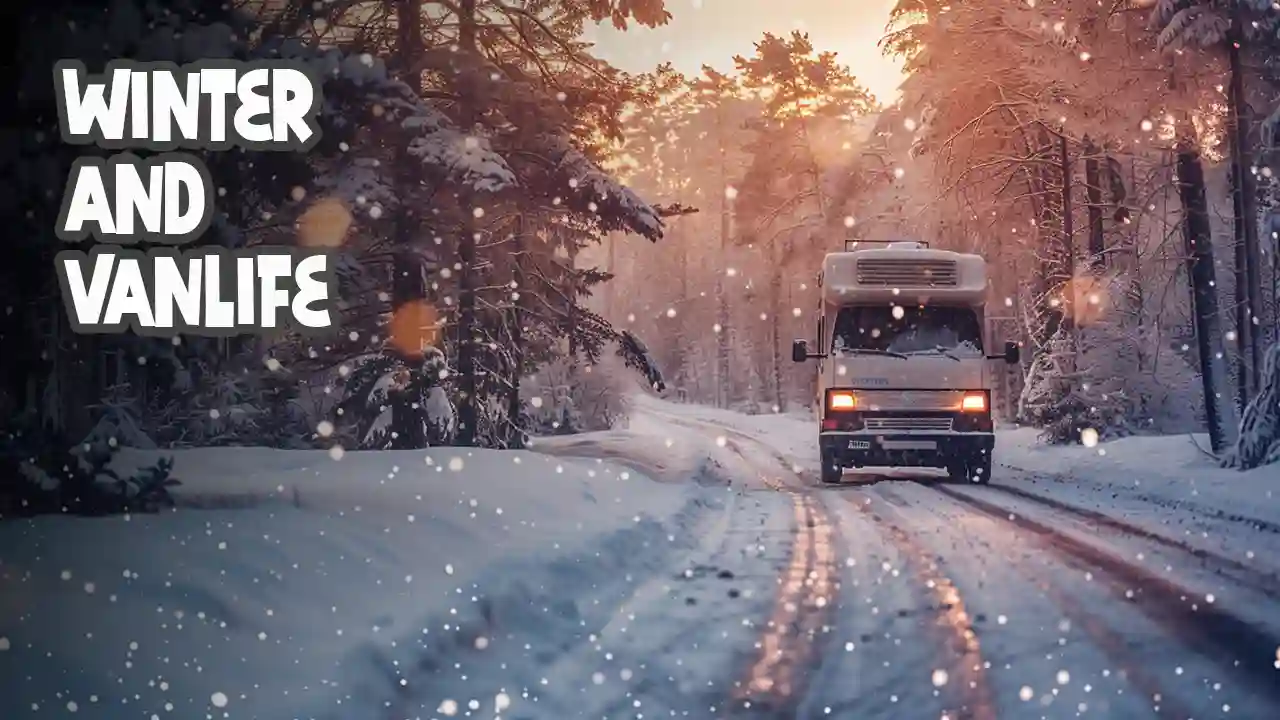
How to Live in a Motorhome During Winter?
Introduction
Winter, with its blanket of snow and crystal-clear nights, can be a season of captivating beauty. However, for those of us who embrace van or RV living, this time of year presents unique challenges. The question then arises: ‘How does one thrive in a van or RV during winter?’ In this article, we, Caroline and Xavier, will share with you the invaluable lessons we’ve gathered throughout our journeys across Europe’s winters.
From the essentials of cautious driving and specialized gear for wintry roads, to energy management and insulation, tips for staying warm, and strategies for locating open campgrounds, we’ve got it all covered.
Get ready to dive into a wealth of practical advice and survival tricks to make your winter vanlife experience a cozy and joyful adventure.
Vanlife in Winter Video
While we’re in the process of creating a YouTube video on this topic, we offer you a video of a vanlife city trip to Bragança, filmed in December in Portugal.
Your Customized Vehicle and Winter
Prepare Your Tires and Exercise Increased Caution on the Road
Winter in an RV is a symphony of frost-laden landscapes and unique challenges, particularly when it comes to driving. The roads, cloaked in snow and ice, become delicate dance floors where every turn is a calculated step. The first snowfall, though magical, brings with it a silent peril, demanding unwavering vigilance.
Outfitting our trusty Edouard for these conditions is paramount. Tire chains or snow tires are the unsung heroes of this season, providing our home on wheels the traction necessary to cling to the most whimsical roads.
However, even with the right equipment, caution remains paramount. Reducing our speed, maintaining a generous safety distance, and avoiding sudden movements are the essentials of winter driving. The snowy road is highly unpredictable, its mood shifting with the slightest storm. Moreover, this will also have a positive impact on your fuel consumption and the lifespan of your brake pads. So, take it easy!
Batteries and Winter Challenges in a Van
Winter presents a specific energy challenge in our van life. With shorter days, the sun is a scarce guest, limiting the charge our solar panels can accumulate. It’s a simple yet relentless reality:
less light means less power
And in the biting cold of winter, our batteries, just like us, feel the sting of the frost.
Batteries don’t take well to the cold. Low temperatures diminish their efficiency, restricting their ability to retain and deliver power. It’s akin to operating a mobile phone on a chilly winter day; the battery drains at an alarming rate. Therefore, it’s essential to insulate them against the cold, not with scarves or hats, but with practical insulation and, if feasible, a warmer location within the van.
There’s another remedy at hand: We can counteract these issues by being frugal with our energy usage. This involves turning off non-essential lights, unplugging unused devices, and generally being (even more) mindful of our energy consumption.
Check Your Plumbing
Winter in a van calls for special attention to plumbing. Cold and water are a troublesome duo, especially when temperatures dip below freezing. Frozen water in pipes can lead to blockages or even cause the pipes to burst, a scenario every vanlifer wants to sidestep.
That’s why regular checks of your plumbing system aren’t just recommended, but necessary.
Knowing where your pipes run is crucial. Areas exposed to the external cold are most vulnerable. Insulating these pipes is a proactive step in preventing freezing. There are several methods, such as using heat tapes or insulating foams. The goal is to minimize exposure to the cold and maintain a stable temperature in critical areas of your plumbing.
But don’t stop there. Consider draining your pipes if you plan to park for an extended period in icy temperatures. An empty plumbing system is a safe one. Additionally, keep an eye on the weather. If a cold snap is forecasted, take preventative measures. A little maintenance and vigilance can save you a lot of hassle and unnecessary expenses.
You (the Traveler) and Winter
Humidity, Not Cold, is the True Foe
In van life, especially during winter, humidity is often a more formidable adversary than the cold itself. Excessive moisture inside the van can make the chilly atmosphere even more biting, seeping into clothes and skin, creating a sensation of intensified cold. This is because moist air conducts cold better than dry air, intensifying the bite of winter chill.
It might seem counterintuitive to crack open your van’s windows in the dead of winter, but regular ventilation is crucial to swap the moist interior air with drier air from outside.
This helps control the humidity level in the van, making the air drier and, consequently, warmer. A brief period of airing out, even just a few minutes daily, can make a substantial difference.
In addition to airing out, using dehumidifiers or moisture-absorbing substances, such as silica gel, can also assist in maintaining a drier and warmer indoor environment.

Boosting Insulation by Covering Your Windows
Insulation is the cornerstone of staying warm in a van during the chilly months. As soon as the sun sets, the temperature inside can plummet drastically, especially through the windows which, unfortunately, lose a great deal of heat. Our van, Edouard, might be small, but it’s our sanctuary, and every degree of warmth matters. That’s why covering the windows is a critical step in preserving that precious heat.
Okay, now that we know that windows, despite their size, are the weak spots in the battle against the cold, what do we do? Using insulators such as thermal curtains, or even heavy blankets can make a significant difference. It’s about creating a barrier, a bulwark against the external cold. And in our compact space, even a minor improvement in insulation can have a massive impact on comfort. So, it’s essential to close your blinds as soon as the sun sets and not wait for them to soak up the cold.
So, as the sun begins to dip, get ready. Cover those windows and keep the warmth inside. After all, every little degree counts.
Your New Winter Companions: Blankets and Fleece Clothing
As winter’s chill sets in, warming up becomes a priority, and what better way to do that than with textiles designed to retain heat? Enter the realm of blankets and fleece clothing, your new best friends for winter in the van. These materials are champions at holding in warmth, providing you with an extra layer of comfort during those cold nights.
Fleece clothing, in particular, is a wise choice for vanlifers.
Lightweight, soft, and, most importantly, incredibly warm, they add an insulating barrier between you and the biting cold. And let’s not forget about blankets. These coverings aren’t just for comfort; they trap heat, creating a much-welcomed bubble of warmth.
Using Sleeping Bags on the Bed
Continuing with the theme of thermal comfort, employing sleeping bags on the bed emerges as a clever hack for wintry nights in the van.
Designed for the coldest environments, they wrap the body in an insulating embrace, retaining body heat more effectively than a traditional duvet.
Sleeping bags are valuable allies, especially if you’re a duo. You can unzip them and spread them out like a large shared blanket, creating a snug cocoon for two. This versatility isn’t just convenient; it amplifies warmth by utilizing each person’s body temperature. It’s a savvy way to stay warm without expending extra energy on heating.
In the battle against winter chill, every layer counts, and a sleeping bag is, without a doubt, a powerful armor in any vanlifer’s arsenal.
Stay Hydrated and Eat Well
Hydration and proper nutrition are crucial in winter, especially when living the vanlife. The cold often deceives our sense of thirst, reducing our water intake, but the need for hydration remains constant, regardless of the temperature. Therefore, it’s vital to maintain regular water consumption, just as you would in summer.
Keeping a water bottle within reach and drinking regularly throughout the day can help maintain proper hydration.
Regarding nutrition, the body expends more energy to stay warm in cold climates, increasing our caloric needs. Choosing foods high in calories and nutrients is wise during the winter months.
Incorporating foods like nuts, seeds, legumes, and healthy fats can provide a sustained energy source.
Additionally, warm meals are not just comforting; they help raise your body temperature from the inside.
Living Spaces in a Van During Winter
Finding Open Campgrounds
A tangible challenge of van life during winter is locating campgrounds that remain open. Many shut their doors during the colder months, significantly reducing options for secure and equipped stops. This reality calls for extra planning, as the number of comfortable spots dwindles drastically.
Using apps and websites dedicated to campgrounds can assist you in identifying those that stay operational year-round.
Keep in mind that available services may be limited, even at open campgrounds, due to lower attendance.
However, this scarcity of campgrounds can also be seen as an opportunity to explore new places. Public parking areas, though less picturesque, can be viable alternatives. Moreover, it encourages a more self-sufficient form of vanlife, pushing you to be more independent in terms of energy and resources.
Why Stay in the Cold?
If winter becomes too harsh, it’s reasonable to ask: why stay in the cold? Living in a van offers unprecedented mobility, and for those not particularly attached to wintry landscapes, heading to milder climates is a viable option. It’s a strategy we’ve embraced whenever possible, and the benefits are manifold.
Moving to warmer regions, even if it means a longer journey, can actually be economically advantageous.
Firstly, a milder climate reduces the need for constant heating, allowing for significant energy savings. Additionally, the longer, sunnier days in southern regions are beneficial for our solar batteries, ensuring more efficient and reliable charging.
Moreover, there’s the comfort and quality of life. Warmer temperatures mean less battling with cold and damp, less stress on the van’s systems, and more opportunities to enjoy the outdoors. Ultimately, the decision to stay or go depends on your personal preferences, but it’s undeniable that chasing the sun has practical and comfortable advantages. After all, the beauty of van life lies in this freedom of choice, allowing you to change your surroundings based on your desires.




